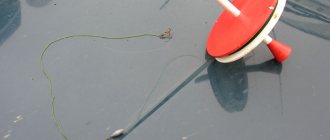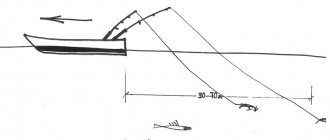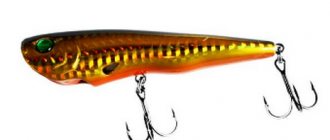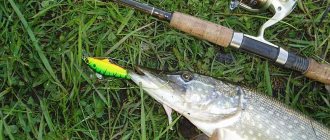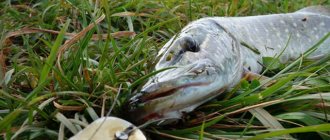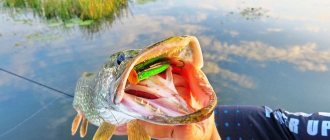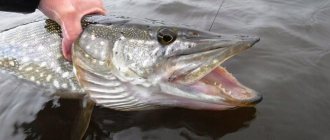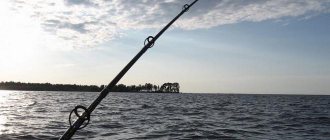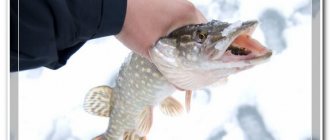Catching a toothy predator with a wobbler can be very catchy, especially during times of increased pike activity. The convenience with which you can replace an artificial fish with another similar bait allows the fisherman, through trial and error, to select a wobbler of the color and size that is “trend” for pike today.
Among the many advantages of using artificial baits over live fish, the most noticeable is the “longevity” of wobblers. Such products, even after hundreds of casts, continue to play attractively for the predator in the water column; live bait cannot withstand this attitude towards itself and often dies from the sharp teeth of the predator or from numerous impacts on the surface of the water after just a few casts.
Wobbler selection
In order to reduce the number of wobblers that can be offered to pike “for lunch,” you should know its basic gastronomic preferences:
Size
If the fisherman does not strive to catch the pike of his dreams, then using small wobblers 5–8 cm long can quantitatively catch much more predatory fish.
If you go pike fishing for a trophy specimen, then the length of the wobbler must correspond to the expected catch.
When using an artificial fish 15 cm or more in length, the number of bites noticeably decreases, but only large pike are interested in such artificial bait.
The advantage of using large wobblers is that the bites of perch and pike-perch are completely eliminated, which, when specifically hunting for pike, are quite often a “by-product” of such fishing.
Small baits work especially well in shallow water overgrown with aquatic vegetation. In such places, the grass pike is located in the “green” and pounces on the fish swimming by. A wobbler that is passed past an ambushed pike is rarely ignored by this fish.
Small wobblers for pike are in great demand by other predators, so the use of small wobblers can be more profitable in terms of quantity.
Color
Artificial fish of silver and gold colors are the most catchy , but during the feeding period, which usually occurs for this predator in March, the color of the bait does not matter much, because at this time the predator rushes at everything that moves.
Form
To catch pike, you can use artificial baits of any shape ; pike are often interested in baits in the shape of frogs and small rodents. A universal bait for catching toothfish is a bait in the shape of an elongated fish.
Depending on the season and time of day
- After the spring zhora , the pike begins a significant period of inactivity. At this time, the fisherman should especially carefully select bait in order to interest this fish. Often, you have to move along the shore or across a body of water by boat in search of a predator hidden in the algae.
- The peculiarity of catching a toothy predator in the summer is that pike does not like too warm water and at this time of year goes a considerable distance from the shore. Pike are found mainly in deep holes filled with snags. For effective fishing in such places, wobblers of a sinking design are used. To reduce the likelihood of snagging, it is necessary to remove all hooks from the bait, except for the one located in the tail part.
- The morning hours are considered the most effective for catching pike in summer. At this time, the fish can come out of its shelter in shallow water and purposefully hunt for frogs; it is at this moment that the frog wobbler, which is carried out in a stepwise manner along the shore, will be the most catchy.
- Autumn time for pike fishermen can be so productive that many toothfish hunters only fish for pike with a wobbler at this time of year. Pike begin to feed heavily in the fall before the hungry winter period. In September, this predator can be found on the edges and in shallow waters, where this fish enters after schools of fry that have grown over the summer.
As the water temperature drops, the pike moves further and further from the shore and hunts at a depth of 2–4 meters. This is due to the fact that the food supply that the pike feeds on at this time sinks into the lower layers of the reservoir.
How to fish with a wobbler from the shore and boat
Pike fishing with wobblers requires a certain rod. As a rule, this is a stick of medium action with a dough from 10 to 45 g. The amplitude of the bait reflects the frequency of oscillations at the tip of the spinning rod, so working with a fast blank is uncomfortable. The predator prefers uniform wiring, so the “twitch” technique is effective - animation using short twitches to the side.
To learn more:
Rating of the best wobblers for pike
To fish from the shore, take a medium-sized rod up to 2.4 m tall. It is difficult to cast with a taller model, because shrubs, grass and trees grow along the banks of reservoirs. Fishing from a boat does not require long poles; you can swim to any promising point. Returning to the question of the price of baits, we note that when fishing on the shore there are more losses; it is not always possible to unhook an expensive wobbler from a branch on the opposite bank or remove it from a snag in the middle of the reservoir.
It is better to take a reel with a size of 2000-3000 units; such a spool is enough for long casts and fighting large trophies. The cord should have a greater margin of strength than when fishing with a jig. Instead of thick fluorocarbon leaders or tungsten, spinners use metal twists.
Best lures
Tigercub 205F
This bait, weighing 70 grams and 20.5 cm long, is used exclusively for catching large pike. Despite its size, Tigercub 205F has an excellent game that imitates the movement of a live fish, and its realistic coloring can deceive even an experienced sharp-toothed hunter. The wobbler has positive buoyancy, which makes it ideal for carrying this bait in overgrown reservoirs.
Thanks to the artificial fish located inside, the noise chamber additionally attracts the predator due to the formation of a sound effect. Possessing excellent flight characteristics, the wobbler can be thrown a considerable distance from the shore.
The price of the bait is 1200 rubles.
Junglecat 140F
A minnow-type wobbler has neutral buoyancy and is ideal for long-distance casting. The bait has a noise chamber, which can attract a predator when moving the bait at a considerable distance. The wobbler is 14 cm long; this rather large bait brings the fisherman mainly only trophy pikes. An artificial fish equipped with sharp tees does not leave a chance for a predator to taste this bait with impunity.
Price – 900 rubles.
Rongubei 90 F
The wobbler is 9 cm long, ideal for hunting small and medium-sized predators. The bait is especially effective in ponds overgrown with vegetation when fishing at a depth of 1 - 1.5 meters.
Price – 500 rubles.
Fishing tackle
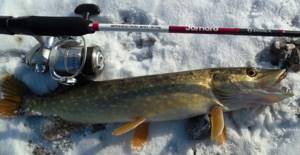
- Pike fishing with artificial fish is carried out mainly with spinning rods. Ultralight class rods are not used for pike fishing; the resistance of a predator when fishing can be significant and exceed the breaking force of this tackle.
- The rod test should be within 10 – 70 gr. The length of the stick depends on the fishing conditions. If fishing for a predator is carried out from the shore, then to carry out distant requests, a rod of at least 3 meters long is required.
- When catching a predator is done from a boat , then due to the ability to get as close as possible to the location of the predator, there is no need to use a rod more than 2 meters long.
- A rod for catching a predator must be made of a material that will allow the fisherman not to fear for the safety of the trophy and equipment. The most advantageous is the use of structures made of composite material, which, in addition to a high tensile load, are also lightweight, which is always important when spinning fishing.
- A spinning reel must correspond to the high title: “a spinning reel for catching predatory fish.” For pike hunting, large spinning reels are used, the spool of which is capable of winding at least 150 meters of fishing line with a diameter of 0.5 mm. The gear ratio of the reel must be large enough so that when fishing for a large predator, the resistance of the fish, which will be transmitted to the reel handle, decreases in proportion to the increase in the gear ratio of the reel mechanism.
- To catch pike, use monofilament or braided cord , always of high quality and using a steel leash, which will not allow the toothy predator to tear off the bait.
Catching pike with a wobbler on the bottom of a reservoir
For fishing along the bottom of a reservoir, stepped fishing is used. After splashdown, the wobbler is deepened using a reel or by pulling the rod until it touches the bottom. Then there is a pause of 3 - 5 seconds, after which the deepening actions are repeated again. Such a wobbler jig often brings trophy catches.
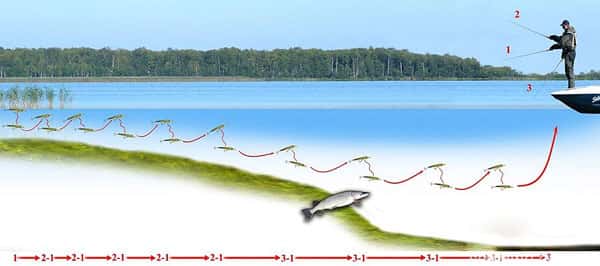
Catching pike with wobblers and jig baits (Educational film)
Choosing a place and time
- Catching pike with a wobbler can be done at night. Usually this predator is well caught at night from June to September and, unlike fishing during the day, it goes to the shallows, where at this time there is a lot of food for it in the form of small fish. If a neutral buoyancy wobbler is used in such places, then success is guaranteed.
- For night fishing, it is necessary to give preference to artificial fish with a noise chamber . It is thanks to this device that the predator, which practically cannot see in night water, will feel vibrations in the lateral line and make an attack.
Daytime fishing depends very much on the time of year:
- In summer, pike prefers to feed in the early morning and at dawn.
- In the spring, during the feeding season , it attacks the bait throughout the day.
- Autumn hunting for this fish is also possible throughout the daylight hours and the best option would be spinning fishing from a boat. In this way, you can fish large areas of a reservoir, constantly moving from one place to another. In late autumn, wobbler models of sinking design should be used. The ones most in demand by predators at this time of year are oblong minou-type baits.
- A large predator always prefers deep places for hunting. Decent-sized pike can be caught in shallow water only at night. In small areas there are a lot of grass pikes, for catching which wobbler models no more than 8 mm long are selected.
- It is very difficult to catch pike in winter. This predator is caught using a wobbler only when there is no ice cover. Wiring at this time should be carried out twice as slow as in warm water.
Catching pike with a wobbler in dense vegetation
For fishing in the grass that reaches the surface of the water, poppers and walkers are used. The most effective bait for such conditions is the Croatian egg. Due to its structure, the powerful hook is located above the wobbler and does not catch vegetation at all. The wiring used is jerky with pauses. When carried through the water, the bait combines the squelching of a popper and the wagging of a wolf.
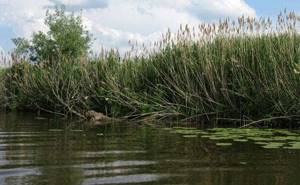
Catching pike with wobblers in the grass (Video)
Wobbler fishing technique
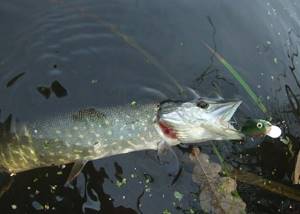
Depending on the depth at which the pike is located, a bait model is selected, which should remain at the surface of the reservoir or sink to the bottom immediately after casting.
Retrieving in the upper layer of water is carried out evenly with short pauses and twitching of the rod tip.
If the predator is located at a considerable depth, then elongated sinking models are used to hunt it.
In this case, wiring is carried out in steps with significant pauses. When retrieving, you need to try to imitate a sick or stunned fish; such prey is always a priority for pike.
When catching a predator from a boat, it is possible to get as close as possible to the hole where the predator is located, but you should not stand above the place where the predator is hiding. You should position yourself at some distance from this place and cast the bait so that the wobbler ends up behind the hole in which the predator is located. Then, using even wiring, you need to wind the line so that the bait passes through the area where the pike is located.
Only fish of sinking models are suitable for such wiring, which immediately sink to the bottom after casting the bait.
Blitz tips
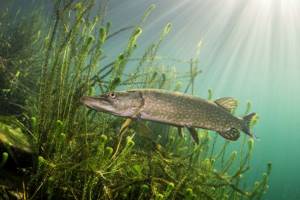
- High-quality wobblers, despite the high price, are very catchy , due to the fact that the latest developments in the field of aero- and hydrodynamics are used to create them, the latest materials and dyes are used, which are applied to the surface of the bait using nanotechnology. It is impossible to produce a decent product in artisanal conditions, and cheap fakes are proof of this.
- It is very unsafe to throw an expensive wobbler into holes littered with tree trunks and snags, but it is in such places that trophy pike are found during daylight hours.
- In order to catch both the fish and the wobbler not to be left at the bottom of the reservoir , you should properly equip the artificial fish. It is relatively safe for bait to catch a predator in such places if you remove the additional tees from the wobbler, leaving the hook only in the tail part. The tips of the tail hook should be slightly bent inward, and for greater non-snacking, small pieces of edible silicone should be placed on the hook so that the rubber completely covers the sharp part of the hook.
- When going pike fishing , you should definitely take a yawner, a device that allows you to free the bait that has been swallowed too deeply by a hungry predator.
- When placing bait in reservoirs overgrown with aquatic plants or near the bottom , the hooks can become dull very quickly, which will negatively affect the fishing results. You can sharpen the hook tip using a matchbox.
